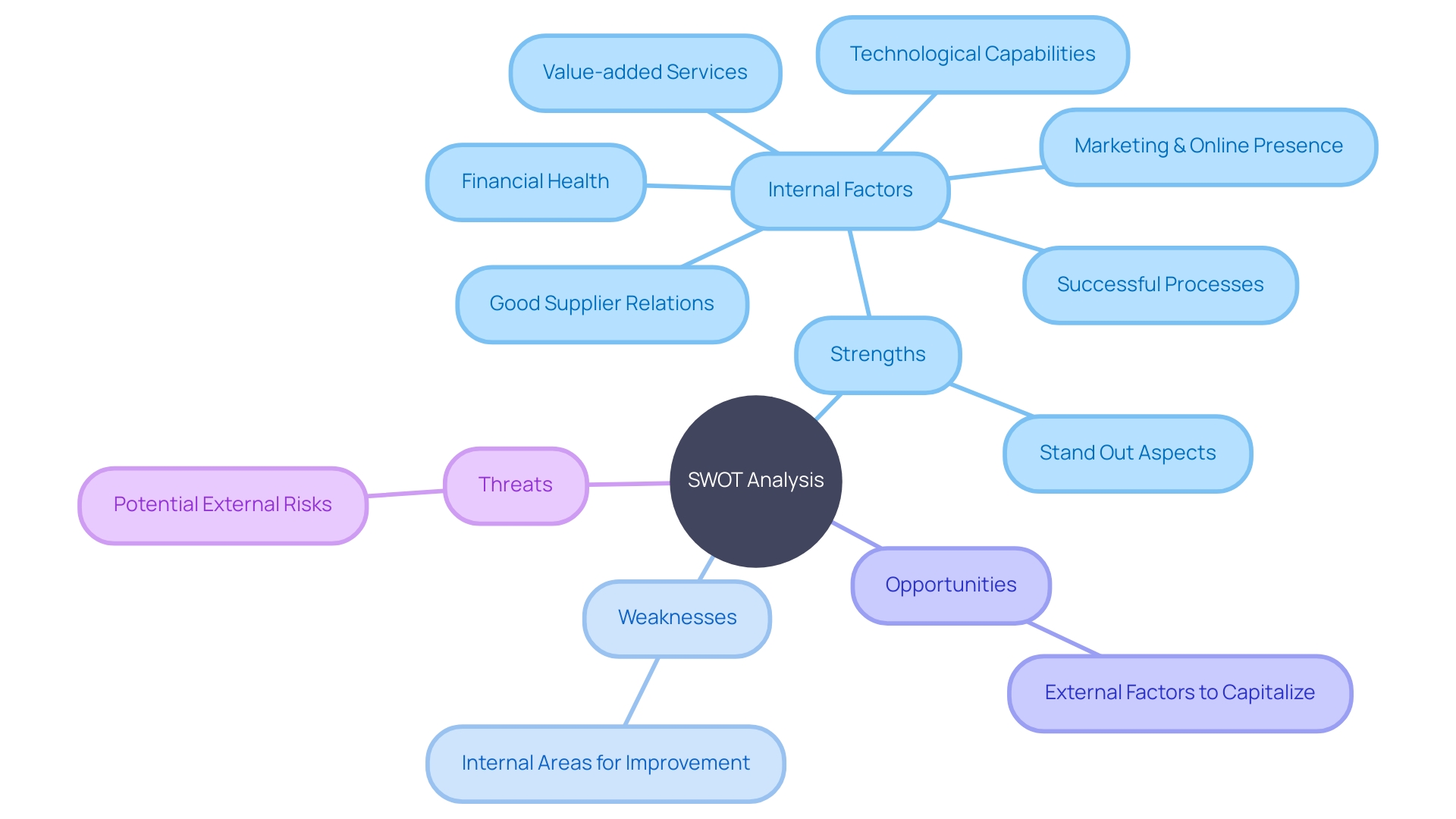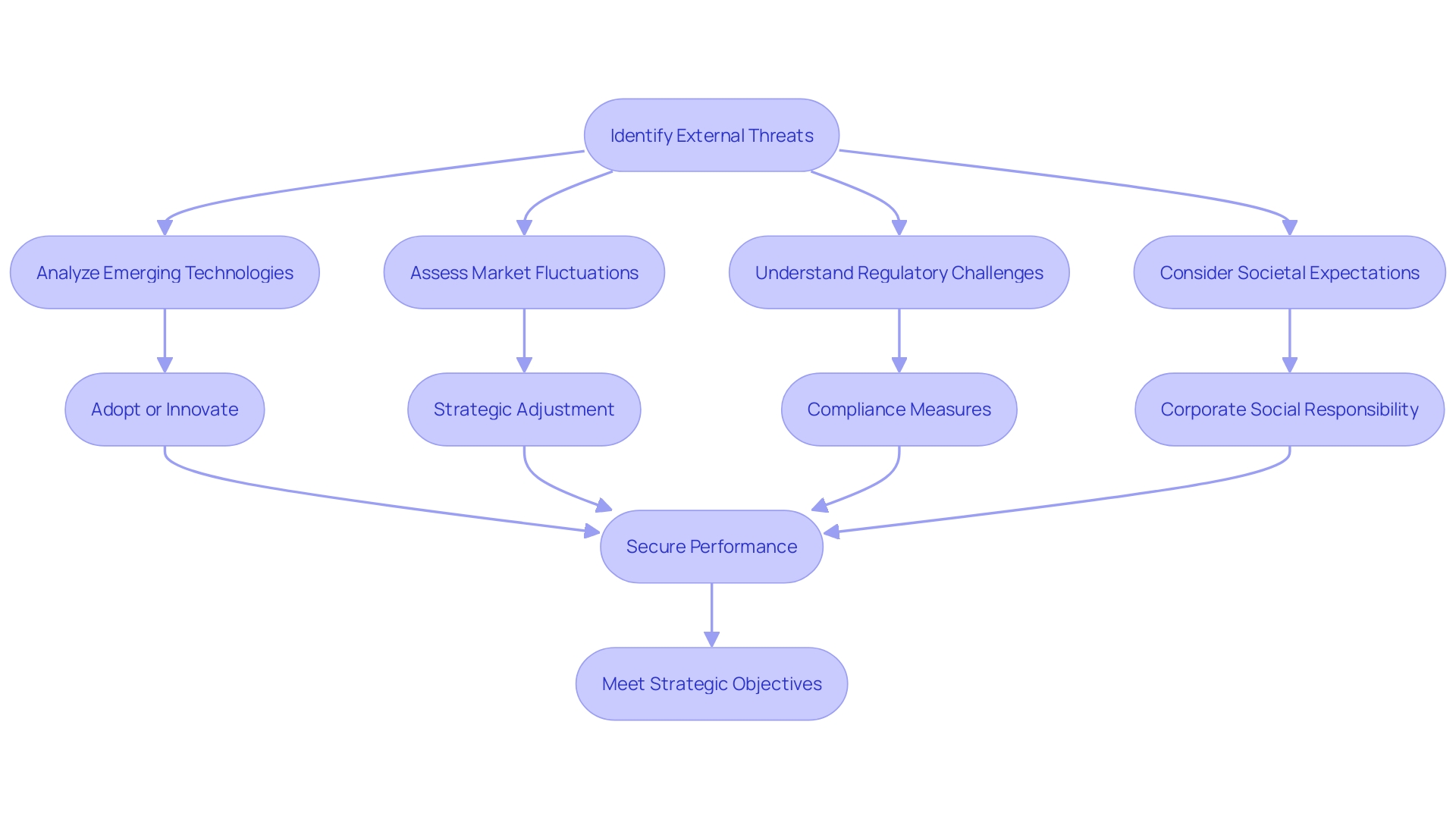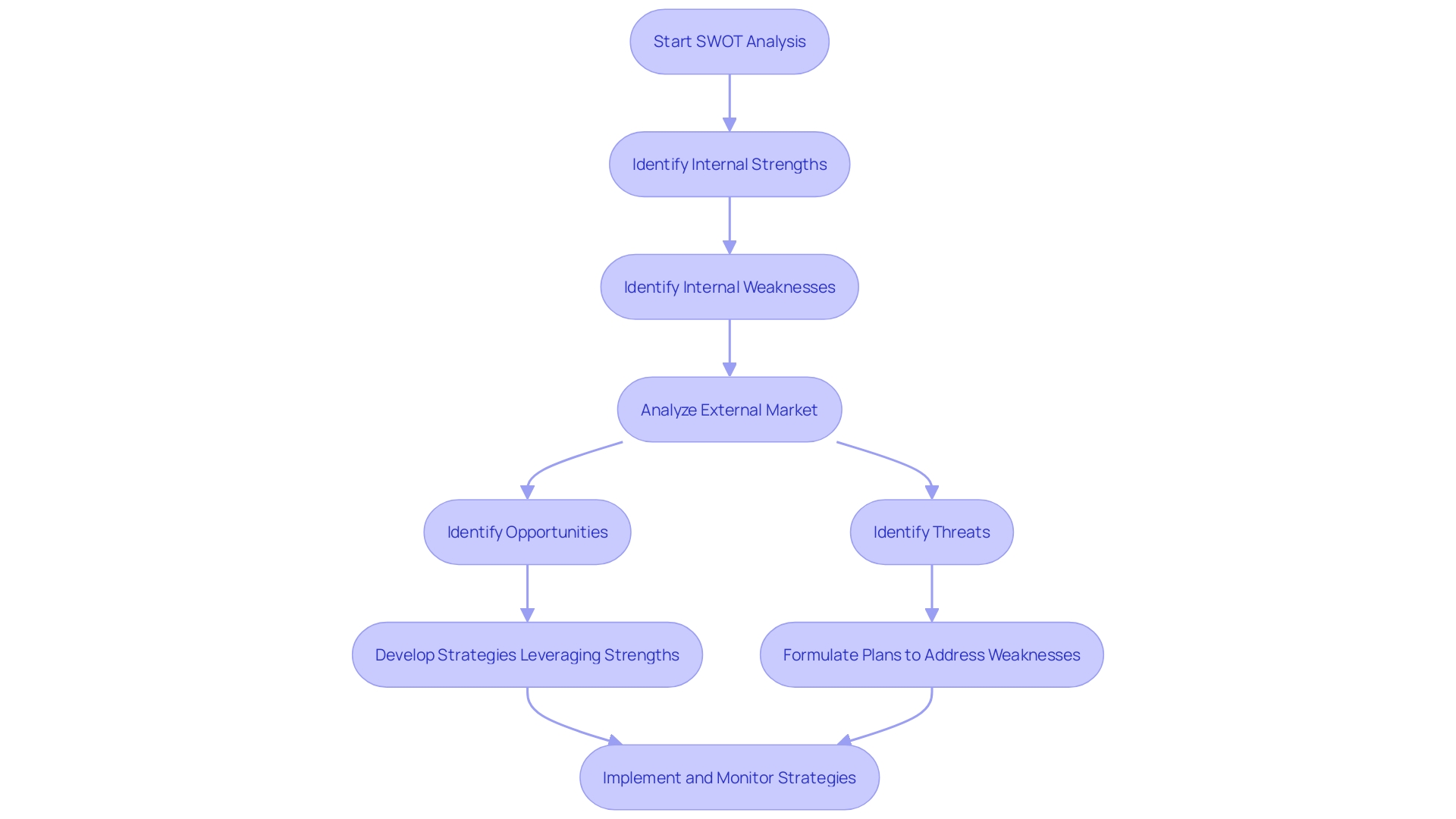Introduction
In the arena of dynamic markets and complex business requirements, a SWOT analysis emerges as a beacon that illuminates an organization's present conditions and outlines the path ahead. It dissects the essence of an organization by highlighting what it excels in - these are the strengths; the aspects it might lag in - labeled as weaknesses; and scans the horizon for both the opportunities it could seize and the threats it should guard against.
Notwithstanding its size or lifecycle phase, every business can harness the SWOT framework to gauge where it stands amid the industry throng. This element of strategic planning not only reveals your distinct competitive edge within the marketplace but also furnishes a blueprint to bolster your business's internal mechanisms.
It is through the meticulous articulation of strengths such as exceptional supplier relations, a robust market presence, or superior marketing strategies, that an organization can both magnify its position and adroitly navigate the external business environment. Moreover, it serves as a vital precursor to competitive analysis, which further refines one's understanding of where the rivals excel or fall short. By systematically identifying these elements, your organization can craft incisive strategies to leverage positives and shore up areas of improvement, steering towards sustainable growth and market leadership.
Understanding SWOT Analysis
In the arena of dynamic markets and complex business requirements, a SWOT analysis emerges as a beacon that illuminates an organization's present conditions and outlines the path ahead. It dissects the essence of an organization by highlighting what it excels in - these are the strengths; the aspects it might lag in - labeled as weaknesses; and scans the horizon for both the opportunities it could seize and the threats it should guard against.
Notwithstanding its size or lifecycle phase, every business can harness the SWOT framework to gauge where it stands amid the industry throng. This element of strategic planning not only reveals your distinct competitive edge within the marketplace but also furnishes a blueprint to bolster your business's internal mechanisms.
It is through the meticulous articulation of strengths such as exceptional supplier relations, a robust market presence, or superior marketing strategies, that an organization can both magnify its position and adroitly navigate the external business environment. Moreover, it serves as a vital precursor to competitive analysis, which further refines one's understanding of where the rivals excel or fall short. By systematically identifying these elements, your organization can craft incisive strategies to leverage positives and shore up areas of improvement, steering towards sustainable growth and market leadership.

Components of SWOT Analysis
SWOT analysis serves as a comprehensive strategic planning tool for determining the internal and external factors that can affect an organization's success. A SWOT framework evaluates an organization’s significant internal positives—or strengths—like successful internal processes, superior supplier relationships, marketing prowess, and technological advancements which set it apart in the industry.
Conversely, weaknesses are internal aspects that may hinder performance, including inefficiencies or resource limitations that need attention. External, opportunities are elements in the environment that the organization could exploit for its advantage, while threats entail potential challenges like competition or market changes that could impede growth.
Conducting a SWOT analysis isn't just about listing these factors; it's about comprehensively understanding the unique position of your business within the dynamic landscape of your industry and using this knowledge to shape strategic decisions. Relevant, accurate competitive analysis can be invaluable in pinpointing where you stand relative to others in your market—informing you of competitor strengths to emulate or weaknesses to capitalize on. Ultimately, the insights derived from a rigorous SWOT analysis support the development of robust strategies to leverage your company’s capabilities, navigate deficiencies, and align with the realities of the business environment, propelling you toward your desired future state.
Examples of Threats
In the dynamic landscape of global markets, external threats are ever-present, often stemming from technological advancements, market fluctuations, and complex regulatory environments. For instance, the global race in technological evolution raises questions on ethics and governance that could impact an organization from legal standpoints.
Emerging technologies may bring about niche innovations, such as video accessibility plugins, which while advancing inclusivity, also present potential threats through market competition and the need for organizations to adapt rapidly. Furthermore, understanding the historical context, such as the centennial use of telehealth that began with the 1874 health-related telephone calls, shows that longevity of technology does not shield from contemporary threats but instead invites ongoing ethical and regulatory considerations.
The legal and regulatory frameworks pose their challenges, revealing gaps in oversight that require attention to mitigate risk. The Ford Foundation’s digital content strategy overhaul illustrates a proactive measure against such threats; they moved from a content bottleneck to a more fluent system accommodating a quadrupled content output.
This evolution underscores the threat that stagnant digital engagement strategies can pose in a world where digital content proliferation and consumption are accelerating. Social goals linked to research and technology also frame threats through public scrutiny and societal expectations. In the case of the Ford Foundation, their shift towards a more efficient content delivery system was not merely operational but also served their mission for social change. Though not exhaustive, these illustrative vignettes speak to the multifaceted nature of external threats—technological, competitive, regulatory, and social—that organizations must navigate to secure their performance and strategic objectives.

Strategies for Addressing Threats
In navigating through the complexities of today's business environment, a deft approach is critical for pivoting from identified threats to actionable strategies. A SWOT analysis propels organizations forward by enabling them to identify and harness their strengths—those internal, positive factors they can control, such as efficient processes, strong market positioning, and robust digital presences.
Following the SWOT framework, organizations can reassess their landscape and craft strategies that accentuate these strengths while transforming weaknesses and external threats into opportunities. As the threat of cyber attacks looms large, a key strategy lies in strengthening cybersecurity measures.
It is imperative for businesses to recognize the catastrophic potential of such risks and allocate resources for robust cybersecurity protocols effectively. A proactive measure, such as investing in security systems, will protect consumer data and safeguard the company's digital infrastructure.
Furthermore, a key takeaway from 'How Big Things Get Done' resonates here: understanding and managing risk is paramount. Leaders must enhance their risk intelligence by relying on solid information and sidestepping biases. Another aspect to continuously refine is one's competitive advantage in tune with shifting forces of assets, aspirations, market realities, and consumer demand, which provides a buffer against external adversities. Thus, by embracing these strategic imperatives, companies can not only repel threats but pivot them into stepping stones for triumph.
Best Practices for Conducting a SWOT Analysis
Adeptly utilizing a SWOT analysis equips organizations with a keen understanding of their unique position within their industry. This strategic planning framework spells out strengths, weaknesses, opportunities, and threats, providing the scaffold for sound business strategies.
To begin, identify the innate strengths of your outfit—these could be superior market presence, robust online visibility, strong supplier connections, or enhanced service offerings. These attributes should be the linchpin of your strategy; they offer a paramount edge over competitors.
Internal processes that are yielding favorable outcomes are invaluable, but to ensure a holistic and effective SWOT analysis, also scrutinize the wider market. Conducting thorough competitive analysis reveals not just your fortitudes but also the areas where rivals might outshine you.
This introspection and market surveillance, when combined, steer your organizational strategies towards utilising inherent strengths to cushion weaknesses and to adapt to the external business milieu. Significantly, a recent global survey depicted a shift towards an older, more experienced respondent demographic in the business analysis arena, spotlighting evolving professional insights ready for harnessing. Applying this strategic understanding is key to developing effective responses to an ever-shifting business landscape. As you reappraise your business state, leverage these seasoned perspectives to advance your strategies, relying on SWOT analysis to gauge and respond to the operational environment effectively.

Common Limitations of SWOT Analysis
A SWOT analysis, while an integral asset for strategic planning, demands a nuanced approach that acknowledges its inherent shortcomings. For instance, Toyota's Woven Planet venture, a compelling idea theoretically, encountered real-world hitches. Despite its ambitious vision of creating software to become the industry standard—a system that would work across diverse vehicle types and connect to a cloud network—execution fell short of expectations, hampered by an overambitious scope and rigid timelines.
As the cautionary tale of Woven Planet shows, zone management is crucial; each business sector must have its specific mission, metrics, and return on investment landscape to avoid the pitfalls of a great vision poorly executed. Similarly, companies must continually adapt their competitive strategies based on thorough competitive analysis and self-assessment to stay ahead. Identifying internal strengths, such as efficient processes or market advantages, provides a solid foundation upon which to base strategies.
Moreover, a company's awareness of the evolving market context—driven by socio-cultural, economic, and technological changes—is essential to craft a framework that leverages strengths and addresses weaknesses while responding to the external environment effectively. In doing so, businesses not only optimize their current operations but also pave the way for future growth and adaptation, ensuring long-term success. Understanding both internal capabilities and external possibilities and challenges is what makes a SWOT analysis a powerful, albeit not perfect, tool for strategic direction.
Conclusion
In conclusion, a SWOT analysis is a powerful tool that helps organizations assess their strengths, weaknesses, opportunities, and threats. It enables businesses to leverage their advantages and address areas for improvement. By conducting competitive analysis and embracing experienced perspectives, organizations can create effective strategies that utilize strengths and adapt to the evolving business landscape.
It is crucial to understand and address threats, such as technological advancements, market fluctuations, and regulatory environments. Proactive measures, including robust cybersecurity and risk intelligence, can mitigate risks and turn threats into opportunities. Best practices for conducting a SWOT analysis involve identifying internal strengths, analyzing the market, and leveraging insights from professionals.
This holistic approach drives effective decision-making and fuels sustainable growth. While SWOT analysis is valuable, it has limitations. The case of Toyota's Woven Planet venture emphasizes the importance of zone management and focused execution.
Companies must continuously adapt their strategies, stay aware of the market context, and leverage internal capabilities to achieve long-term success. To summarize, a SWOT analysis provides organizations with a comprehensive understanding of their position and informs strategic decision-making. By leveraging strengths, addressing weaknesses, capitalizing on opportunities, and mitigating threats, businesses can navigate the business environment and strive for growth and leadership.




